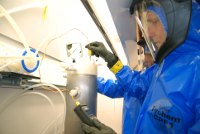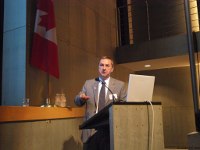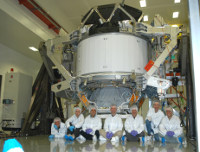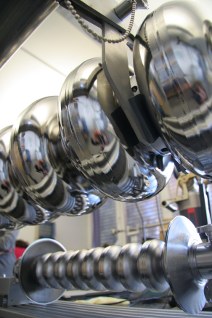Canada moves towards SCRF expertise with e-linac project

TRIUMF researchers examine the chemical etching process for a superconducting cavity manufactured by PAVAC Industries. |
Scientists at TRIUMF laboratory in Canada are wrapping up the design of a new experiment that will give them experience in building superconducting radiofrequency cavities and position them for further collaboration on the International Linear Collider.
Read more...
-- Andre Sulluchuco |
|
 |
Canada-Japan collaboration in accelerator science

TRIUMF Director Nigel Lockyer giving his talk. Image: Embassy of Canada in Japan |
On 7 July, while the Emperor and Empress of Japan were visiting Canada, Nigel Lockyer, the director of TRIUMF, gave a lecture at the Canada – Japan Particle Accelerator Science Symposium at the Embassy of Canada in Tokyo, to commemorate the 80th anniversary of diplomatic relations between Japan and Canada. Today, Canada and Japan are partners in numerous international groups and organisations such as the G8, Asia-Pacific Economic Cooperation (APEC) and the Organisation for Co-operation and Development (OECD). This symposium showcased one of many Canada-Japan collaborations: the active partnership in accelerator science.
Read more...
-- Rika Takahashi |
 |
|
|
 |
From Daily Herald
6 August 2009
Stimulus check will keep Fermilab open for next 20 years
... That course will feature a possible push to be the host site for the International Linear Collider. As the longest ever linear particle accelerator, the device would allow scientists to measure the properties of particles at an unprecedented level.
Read more... |
|
From Naperville Sun
6 August 2009
Welcome home, money
Fermilab outlines ambitious plans to plow millions in stimulus funds into projects that will create jobs for residents
Read more... |
|
From Fermilab
5 August 2009
Fermilab to Receive Additional $60.2 Million in Recovery Act Funding for High Energy Physics
In the latest installment of funding from the U.S. Department of Energy’s Office of Science under the American Recovery and Reinvestment Act, DOE’s Fermi National Accelerator Laboratory will receive an additional $60.2 million to support research toward next generation particle accelerators and preliminary design for a future neutrino experiment.
Read more... |
|
From Daily Herald
5 August 2009
Fermilab getting $60 million more in stimulus funds
... More than $57 million will be used on developing new technology for a particle collider to replace Fermi's Tevatron. The new collider will use superconducting radio frequency technology to send particles hurtling at each other in experiments.
Read more... |
|
From Fermilab Today
4 August 2009
Director's Corner: Future Accelerators
... Our Fermilab plan is to develop first the intensity frontier with Project X and either the ILC or a muon collider depending on what the LHC teaches us about the relevant energy scale.
Read more... |
|
From New York Times
4 August 2009
Giant Particle Collider Struggles
... This week, scientists and engineers at the European Center for Nuclear Research, or CERN, are to announce how and when their machine will start running this winter.
Read more... |
|
From Science Blogs
3 August 2009
Linearbeschleuniger und das Elektronenvolt
...Jetzt geht bald der Ringbeschleuniger LHC an den Start, und danach wird es wohl noch einen riesigen großtechnischen Linearbeschleuniger geben, den International Linear Collider, der gerade in Planung ist und wohl 50 km lang werden soll.
Read more... |
|
From CERN Bulletin
3 August 2009
The latest from the LHC
Three weeks ago vacuum leaks occurred in both Sector 8-1 and 2-3 (See previous update).
Read more... |
|
|
 |
Particle Physics at Academia Sinica in Taiwan

The assembly at CERN of the Alpha Magnetic Spectrometer (AMS) for the International Space Station. The Academia Sinica group has made important contributions to this sophisticated device. |
As a global effort, we are committed to integrating particle physicists from the worldwide community into the ILC physics detector and accelerator design efforts, as well as developing institutional roles for countries that have a significant particle physics programme. Last month, I had the opportunity to spend time at the Academia Sinica in Taiwan where I chaired a review of their Institute of Physics, which has an impressive high-energy physics programme. Although Taiwan is not yet a main contributor to the ILC, I am confident that such an involvement both for Taiwanese universities and Academia Sinica will naturally evolve because of their strong particle physics programmes.
Read more...
-- Barry Barish
Director's Corner Archive |
 |
|
|
 |
Relative values

A rare family portrait of a 1.3 and a 3.9-GHz cavity in the DESY tuning lab. The small cavity is a prototype for the European XFEL, produced by industry under the supervision of INFN Milan, and is based on the design of the cavities in the 3.9-GHz cryomodule developed and built at Fermilab for DESY's linear accelerator FLASH. No cavities were harmed or altered in the production of this photograph.
|
Take the NewsLine survey
Last week we sent around an invitation to take part in our survey to tell us how happy or unhappy you are with NewsLine. It's not too late! Take it here in
English or in
Japanese. The ILC communicators say thanks!
arXiv preprints
0907.5568
Likelihood Functions for Supersymmetric Observables in Frequentist Analyses of the CMSSM and NUHM1
0907.5413
Theoretical Constraints on the Higgs Effective Couplings
0907.5101
Hadronization in three meson channels at tau decays and e+e- cross-section
|
|

